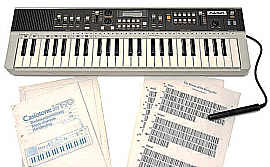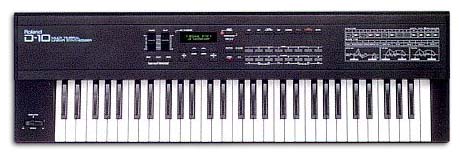A brief history of keys
My brother recently forwarded me the picture above, the mighty Casio MT-70, also my first keyboard. I had actually forgotten I ever owned this plastic wonder so it prompted me to take stock of the gear I’ve used over the years. I still have a keyboard but it gets little attention these days, so much else going on. It waits patiently for my return. Anyway on to the list:
Casio MT-70: tiny keys, limited polyphony, and cheesy sounds. But it was still pretty amazing. Drum beats and comp, real ompa band. And a limited monophonic sequencer, with lights above the keys telling you where to play. It even had a barcode reader and a booklet of songs that could be “scanned” in, teaching music and preparing for a career in retail all at the same time! Ca 1985, cost unknown, not sure what happened to it!
Roland Alpha Juno 1: bought this from a kid in school, my very first programmable synthesizer. A real bend knob for those cool leads. Real size keys but plastic feel, no touch-sensitivity. Cool input wheel though, useful for tweaking the envelopes and filters but with a 16-line display still a chore. Had a special audio jack in the back that could be used to store preset data on a regular casette deck. 1987, 4000kr, traded for D-10.
Roland D-10: bought this at now-defunct Flatøy Musikk in Bergen, a favorite after-school hang-out for many years. When they got the first D-50’s there was a huge buzz surrounding the synth/sample technology, and the D-50 did sound awesome. Unfortunately it was way out of my price range so I settled for the “little brother” D-10 which arrived a year later. The sound was still good although a bit thinner, but it made up for it by having drums and being multi-timbral: it could play up to 8 different instruments when used with a sequencer. Or you could play the internal demo songs which I must have done a million times. 1988, 9000kr, sold in 2017 for 500kr.
Yamaha TG-33, Ensoniq SQ-R: once I started using a sequencer on my trusty Amiga the need for more/new sounds was inevitable. Unlike today when the smallest iMac ships with GarageBand and a gazillion samples, in the old days you had to buy new hardware. The TG was a cheapo version of the Korg Wavestation which was the hot thing at that time, the concept was to “morph” your 4 soundgenerators with a joystick, either in realtime or as a part of the finished sound. It was good for synth-type sounds that pulsated or blended in and out over time. Otherwise the 12-bit samples were pretty cruddy for real-world sounds. The SQ-R however was a very clean sounding module with mostly sample playback, which made for great piano, guitar, etc. 1991-92, $500,$800, handed down to Elaine.
Roland XP-60: this one was kind of an impulse buy, I was looking for an upgrade to the D-10, and also something with a built-in sequencer to simplify recording. I had spent some days playing with a friends Korg M1 and enjoyed the ease of creating music without the computer. But the M1 was getting old at that time and the massive built-in sound library of the XP was a big draw. Unfortunately the XP sequencer is not made to be used by humans, it is cryptic and a pain. So I continued with the computer. It’s still a nice keyboard, good keys with after-touch sensitivity, a massive display, 6 sliders for real-time tweaking of sound parameters, which combined with the arpeggiator makes for loads of fun. 1997, $1200, still playing.
Alesis QS-8: big, heavy monster of a keyboard, 88-keys fully weighted, great piano and organ sounds. Bought it primarily to play with the department band, it also had a lot of good synthy sounds. It was a good looking keyboard, with polished wood ends. 1998, $1400, sold on eBay.





